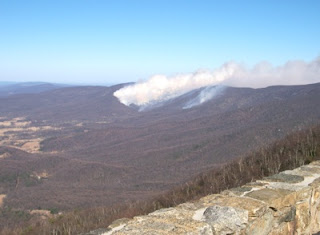PLEASE REMEMBER TODAY IS A RED FLAG DAY.
Reread the post yesterday.
AN escape plan is more than how to get out of your house. When do you go? What do you take? Where do you go? Who do you tell?
Emergency Supplies
When wildfire threatens, you won’t have time to shop or search for supplies. Assemble a Disaster Supplies Kit with items you may need if advised to evacuate. Store these supplies in sturdy, easy-to-carry containers such as backpacks, duffle bags, or trash containers.
Include
■ A three-day supply of water (one gallon per person per day) and food that won’t spoil.
■ One change of clothing and footwear per person and one blanket or sleeping bag per person.
■ A first aid kit that includes your family’s prescription medications.
■ Emergency tools including a battery-powered radio, flashlight, and plenty of extra batteries.
■ An extra set of car keys and a credit card, cash, or traveler’s checks.
■ Sanitation supplies.
■ Special items for infant, elderly, or dis- abled family members.
■ An extra pair of eye- glasses.
When Wildfire Threatens
If you are warned that a wildfire is threatening your area, listen to your battery-operated radio for reports and evacuation information. Follow the instructions of local officials.
□ Back your car into the garage or park it in an open space facing the direction of es- cape. Shut doors and roll up windows. Leave the key in the ignition. Close garage windows and doors, but leave them un- locked. Disconnect automatic garage door openers.
□ Confine pets to one room. Make plans to care for your pets in case you must evacuate.
□ Arrange temporary housing at a friend or relative’s home outside the threatened area.
If advised to evacuate, do so immediately
□ Wear protective clothing -- sturdy shoes, cotton or woolen clothing, long pants, a long-sleeved shirt, gloves, and a handkerchief to protect your face.
□ Take your Disaster Supplies Kit.
□ Lock your home.
□ Tell someone when you left and where you are going.
□ Choose a route away from fire hazards. Watch for changes in the speed and direction of fire and smoke.
If you’re sure you have time, take steps to protect your home
Inside:
□ Close windows, vents, doors, blinds, or noncombustible window coverings and heavy drapes. Remove lightweight curtains.
□ Shut off all utilities if possible, including bottled gas.
□ Open fireplace damper. Close fireplace screens.
□ Move flammable furniture into the center of the home away from windows and slid- ing glass doors.
□ Turn on a light in each room to increase the visibility of your home in heavy smoke.
Outside:
□ Seal attic and ground vents with precut noncombustible coverings.
□ Turn off propane tanks.
□ Place combustible patio furniture inside.
□ Connect the garden hose to outside taps.
□ Set up a portable gasoline-powered pump.
□ Place lawn sprinklers on the roof and near aboveground fuel tanks. Wetting the roof may help if it is shake-shingled.
□ Wet or remove shrubs within 15 feet of the home.
□ Gather fire tools.
Practice Wildfire Safety
People start most wildfires …find out how you can promote and practice wildfire safety.
■ Contact your local fire department, health department, or forestry office for information on fire laws.
■ Make sure that fire vehicles can get to your home. Clearly mark all driveway entrances and display your name and address.
■ Report hazardous conditions that could cause a wildfire.
■ Teach children about fire safety. Keep matches out of their reach.
■ Post fire emergency telephone numbers.
■ Ensure adequate accessibility by large fire vehicles to your property.
■ Plan several escape routes away from your home -- by car and by foot.
■ Talk to your neighbors about wildfire safety. Plan how the neighborhood could work together after a wildfire. Make a list of your neighbors’ skills such as medical or technical. Consider how you could help neighbors who have special needs such as elderly or disabled persons. Make plans to take care of children who may be on their own if parents can’t get home.
Keep important family documents in a waterproof container. Assemble a smaller version of your kit to keep in the trunk of your car.
Wildfires often begin unnoticed. They spread quickly, igniting brush, trees, and homes. Reduce your risk by preparing now -- before wildfire strikes. Meet with your family to decide what to do and where to go if wildfires threaten your area. Follow the steps listed in this brochure to protect your family, home, and property.
Things can be replaced, its devastating to lose your valuables, your memories but as long as you have you those things can be replaced. PLEASE obey all warnings and orders to evacuate.
Tip of the Blog
Make a list NOW you have 5 minutes to evacuate your home and community.
What do you take?
Where do you go?
Who do you tell?
Make the list NOW you only have 4 minutes and 45 seconds .....


































